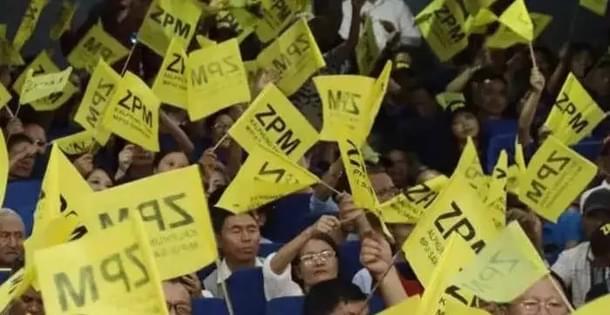North East
Here's Why The Congress Is On A Terminal Decline In The Northeast
Jaideep Mazumdar
Dec 05, 2023, 06:00 PM | Updated 06:00 PM IST
Save & read from anywhere!
Bookmark stories for easy access on any device or the Swarajya app.


Just five years ago, the Congress used to rule Mizoram. Today, it barely survives in this Northeastern state with just one MLA in the 40-member state Assembly.
While the big story from Mizoram has been the spectacular win of the Zoram People’s Movement (ZPM) which was registered as a political party just four years ago, an important sidelight has been the complete marginalisation of the Congress in the state.
The Congress had ruled Mizoram for more than 22 years since Mizoram became a full-fledged state 36 years ago.
For such a party to be cast to the extreme sidelines is a colossal ignominy.
Till not so long ago, the Congress was either in power, or the principal opposition party, in most states of the region. Today, it has been wiped out from Nagaland and Arunachal Pradesh and has a miniscule presence in the five other Northeastern states.
Though it is still the principal opposition party in Assam, with just 29 MLAs in the 126-member state Assembly, the party can barely keep its head above the political waters in the state.
The Congress had ruled Assam for 56 of the 69 years between 1947 and 2016. It lost power to the BJP in 2016 and, since then, has continued to shrink in size and influence in the crucial Northeastern state.
In neighbouring Meghalaya, the Congress was in power for 38 years of the 46 years between 1972 (when Meghalaya became a full-fledged state) and 2018 when it lost power to the National People’s Party (NPP)-led coalition of which the BJP is a constituent.
The Congress suffered an implosion in Meghalaya last year with most of its MLAs, including former Chief Minister Mukul Sangma, defecting to the Trinamool Congress and other parties. In the Assembly elections held earlier this year, it won just five seats.
The Congress was in power for 35 years of the 44 years in the frontier state of Arunachal Pradesh between 1972 (when it became a Union Territory; it got statehood in 1987) and 2016 when all its legislators defected en masse to the BJP.
It has virtually no presence in Arunachal Pradesh today. All its senior leaders have left the party, and it cannot even find people to appoint to its district committees,
In Nagaland, even though the Congress was in power for just 13 years since the state was formed in 1963, it maintained a major presence in the state and even when out of power, it was the principal opposition party.
The Congress lost power in Nagaland two decades ago in 2003, and its presence in the state has been steadily shrinking since then. It doesn’t have a single MLA in the state Assembly now. It has a barely-functioning state office, and most of its district units don’t exist even on paper.
In Manipur, of the 45 years between 1972 (when it obtained statehood) and 2017 (when it lost power to the BJP-led alliance), the Congress ruled the state for 34 years.
In the last elections held in 2022, the Congress won just five seats (down from 28 in 2017) in the 60-member Assembly, but most of them defected to other parties. The party is in a moribund state in Manipur now.
The Congress, along with the CPI(M)-led Left Front, ruled Tripura for the 47 years since it became a state in 1971 till 2018 when the BJP came to power. Though the Congress was in power for 18.5 years of the 47-year span, it remained a strong opposition party when the Left was in power in the state.
But the dramatic rise of the BJP since 2016 saw almost all leaders of the Congress joining the saffron party. The Congress collapsed like a house of cards and in the 2018 Assembly elections, it drew a complete blank with a pathetic 1.79 per cent vote share.
Though the Congress managed to win three seats in the Assembly elections held in February this year, its gain came at the cost of the CPI(M) which saw its tally declining from 16 in 2018 to 11 in 2023.
As for Sikkim, which is considered to be part of the Northeast for administrative and developmental purposes, the Congress simply does not exist there today.
The Congress did have a presence in the Himalayan state in the initial years when it became part of the Indian Union in 1975. But it lost its appeal within a couple of years, and since then the state has been ruled by state parties.
Reasons for the decimation of the Congress
There are multiple reasons for the sorry state that the Congress finds itself in the Northeast today:
Failure to perform
Though the Congress ruled all the NE states for many years, it failed to bring about development--economic, social and physical.
All the states remained poor and socially and economically backward under the long years of Congress rule.
The Congress also failed spectacularly to develop physical infrastructure--roads, bridges, highways etc--in the region. Or even provide quality education and healthcare to the people of the region.
As a result, the Northeastern states lagged behind the rest of the country on all developmental parameters and social indices.
Corruption
The Congress became synonymous with corruption and malfeasance in the region. All Congress governments earned infamy with multiple scams and financial wrongdoings dogging them.
Congress leaders allegedly competed with each other to amass huge wealth. Huge sums of money meant for welfare and development were reportedly syphoned off by corrupt Congress leaders.
It was not just the state Congress leaders who were guilty of these grave misdeeds. The central Congress leadership used to allegedly treat the Northeastern states like ‘mini ATMs’ and a substantial portion of the funds given to the Congress-ruled states of the Northeast by the Union Government used to be taken away by Central leaders.
The Congress central leadership was also accused of encouraging dissent against incumbent Chief Ministers by senior leaders of the state units or senior cabinet ministers.
When such dissent peaked, the Congress ‘high command’ used to depute ‘central observers’ to the state. The beleaguered CM, in order to save his chair, would reportedly offer huge sums of money to the ‘observer’.
This offer--some of it went to the observer’s own pocket and the rest to the central party coffers--would work. Dissension against the CM would die down for a year or two, only to resurface when 'more funds were required by the high command’.
Indiscipline in state units:
The encouragement of dissent against chief ministers or state unit chiefs gave rise to severe factionalism and indiscipline.
All state Congress units were riven by severe discord between multiple groups. Most leaders could not get along with each other, and their supporters indulged in frequent clashes.
Since the party lacked a coherent ideology, power was the only glue that held it together. And people joined the party only for their own gains--to enrich themselves--rather than serving the masses.
Eventually, the infighting and indiscipline weakened the Congress organisationally. The long-suffering common people of the region were also put off by the eternal squabbles between different factions within the Congress.
Failure to gauge popular mood
The Congress was guilty of taking the people of the states it ruled in the region for granted. The party grew on the charisma of Indira Gandhi and, to a much lesser degree, on that of Rajiv Gandhi. And on the dreams that the party promised to the people of the region.
But after Rajiv Gandhi’s death in 1991, there was no charismatic central leader to get votes for the party in the region.
Some popular leaders in the states did carry the party on their backs and won elections, but they had to always look over their shoulders for attempts by their party colleagues to backstab them.
Simultaneously, the opening up of the economy resulted in people’s expectations and aspirations rising. The television boom, and high-speed internet, brought the world closer to the neglected Northeast.
The people of the backward region saw for themselves the strides being made by other states and demanded more. They aspired for a better lifestyle, better and cleaner governance and economic and social development.
The atrophied Congress failed to gauge the mood of the people and meet their aspirations.
Failure to encourage strong state leaders
The Congress central leadership, or the ‘high command’, has always been suspicious of state leaders becoming too popular and strong. The ‘high command’ had always sabotaged the growth of such popular state leaders and benched them out of a sense of acute insecurity.
As a result, many state leaders of the region joined other parties, including state-level parties in their own states. And many who did so eventually became Chief Ministers.
It may be noted here that the present Chief Ministers of Assam (Himanta Biswa Sarma), Arunachal Pradesh (Pema Khandu), Nagaland (Neiphiu Rio) and Manipur (N Biren Singh) and the next CM of Mizoram (Lalduhoma) started their political careers in the Congress.
Meghalaya Chief Minister Conrad Sangma’s father (Purno Agitok Sangma) was a senior Congress leader. Had Purno Sangma remained in the Congress and not formed the Nationalist Congress Party (NCP), Conrad Sangma would also perhaps have been a Congressman.
All these factors have led to the terminal decline of the Congress in the Northeast. The party has been reduced to a footnote in history in almost all the states of the region. And there’s little chance of any revival.





